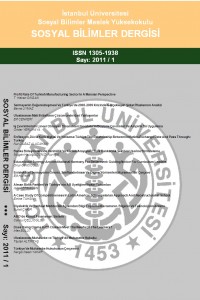Abstract
ABSTRACT
Increasing the quality of education at schools has always been one of the ambitions
educational leaders desire to approach systematically. Therefore, successful
schools have always been placed under the spotlight; while examining how successful
they happened to be and what steps were taken towards becoming a successful
school. This study proposes educational synergy and institutional harmony as the
key to success and draws attention to these concepts as the projection of successful
schools. Having mentioned the significance of creating a synergy and harmony and
pronouncing Hall's Three-Dimensional Model of Culture, the problem of mentality
fossilization at various levels is discussed. Then, the concept of mentality change is
proposed as a solution to the problem.
Key Concepts:
IYILESTIRME CALISMALARINDA EĞITIM SINERJISI VE
KURUMSAL UYUM: MUFREDAT LIDERLERI ICIN YONLENDIRMECI
UYARILAR
OZET
Eğitim liderleri icin okullardaki eğitimin niteliğinin arttırılması her zaman
sistematik yaklasılan bir amac olagelmistir. Bu nedenle basarılı okullar
hep mercek altına alınmıslar; bir yandan nasıl basarılı oldukları incelenirken,
ote yandan basarılı olma yolunda hangi adımların atıldığı belirlenmeye
calısılmıstır. Bu calısma eğitim sinerjisini ve kurumsal uyumu basarının
iki onemli anahtarı olarak onermekte ve basarılı okulların bir izdusumu
olarak bu kavramlara dikkat cekmektedir. Sinerjinin olusturulması ve
uyumun sağlanması icin atılabilecek adımlar tartısıldıktan ve Hall'in Uc-
Boyutlu Kultur Modeli belirtildikten sonra anlayı fosillesmesi kavramtemelli
olasısorunları değsik duzlemleri ifade edilmekte ve bu sorunsala
cozum olarak anlayı değsimi kavramıileri surulmektedir.
Anahtar Kavramlar:
Eğitim sinerjisi, kurumsal uyum, anlayıs fosillesmesi,
anlayıs değisimi, yapıcı iletisim, faydacı etkilesim, kapsayıcı okul.
Educational synergy, institutional harmony, mentality fossilization,mentality change, constructive communication, beneficiary interaction, inclusive
school.
Keywords
Anahtar Kavramlar: Eğitim sinerjisi kurumsal uyum anlayış fosilleşmesi anlayış değişimi yapıcı iletişim faydacı etkileşim kapsayıcı okul
References
- Apple, M., & Beane, J. (Eds.). (2007). Democratic Schools: Lessons in Powerful Education, 2nd ed. Portsmouth, NH: Heinemann.
- Byrnes, H. (1998). Constructing Curricula in Collegiate Foreign Language Departments. In Learning Foreign and Second Languages, 2nd ed. (pp. 262-295). New York: Modern Language Association of America.
- Glatthorn, A., Boschee, F., & Whitehead, B. (2006). Chapter 1: The nature of curriculum. In Curriculum Implementation (pp.3-32). Thousand Oaks, CA:Sage. Development and
- Glickman, C., Gordon, S., & Ross-Gordon, J. (2005). Chapter 19: Curriculum development. In Supervision and Instructional Leadership (pp. 293- 315). Boston: Pearson.
- Gordon, S. (2004). Curriculum development. In Professional Development for School Improvement (pp. 236-261). Boston: Allyn & Bacon.
- Hewitt, T. (2006). Chapter 11: Managing and implementing the curriculum. In Understanding and shaping the curriculum (pp. 287-314). Thousand Oaks, CA:Sage.
- Kavrakoğlu, İ. (1999). Toplumun çıkarı için: Çatışma değil İşbirliği. In Boğaziçi Üniversitesi Mezun- lar Derneği Yayın Organı, summer - pp. 37-40.
- Kugelmass, J. (2004). The Inclusive School: Sustaining Equity and Standards. New York: Teachers College Press.
- Kumaravadivelu, B. (2003). Beyond Methods: Macrostrategies for Language Teaching, Yale University Press, 2003.
- Scheurich, J., & Skrla, L. (2003). Leadership for Equity and Excellence: Creating High- achievement Classrooms, Schools, and Districts. Thousand Oaks, CA: Corwin Press.
- Van Lier, L. (1998). Constraints and Resources in Classroom Talk. Issues of Equality and Symmetry. In Learning Foreign and Second Languages, 2nd ed. (pp. 157-182). New York: Modern Language Association of America.
- Walker, D., & Soltis, J. (1986). Chapter 6: Aims Revisited. In Curriculum and Aims. (pp. 67-83). New York: Teachers College Press.
Abstract
References
- Apple, M., & Beane, J. (Eds.). (2007). Democratic Schools: Lessons in Powerful Education, 2nd ed. Portsmouth, NH: Heinemann.
- Byrnes, H. (1998). Constructing Curricula in Collegiate Foreign Language Departments. In Learning Foreign and Second Languages, 2nd ed. (pp. 262-295). New York: Modern Language Association of America.
- Glatthorn, A., Boschee, F., & Whitehead, B. (2006). Chapter 1: The nature of curriculum. In Curriculum Implementation (pp.3-32). Thousand Oaks, CA:Sage. Development and
- Glickman, C., Gordon, S., & Ross-Gordon, J. (2005). Chapter 19: Curriculum development. In Supervision and Instructional Leadership (pp. 293- 315). Boston: Pearson.
- Gordon, S. (2004). Curriculum development. In Professional Development for School Improvement (pp. 236-261). Boston: Allyn & Bacon.
- Hewitt, T. (2006). Chapter 11: Managing and implementing the curriculum. In Understanding and shaping the curriculum (pp. 287-314). Thousand Oaks, CA:Sage.
- Kavrakoğlu, İ. (1999). Toplumun çıkarı için: Çatışma değil İşbirliği. In Boğaziçi Üniversitesi Mezun- lar Derneği Yayın Organı, summer - pp. 37-40.
- Kugelmass, J. (2004). The Inclusive School: Sustaining Equity and Standards. New York: Teachers College Press.
- Kumaravadivelu, B. (2003). Beyond Methods: Macrostrategies for Language Teaching, Yale University Press, 2003.
- Scheurich, J., & Skrla, L. (2003). Leadership for Equity and Excellence: Creating High- achievement Classrooms, Schools, and Districts. Thousand Oaks, CA: Corwin Press.
- Van Lier, L. (1998). Constraints and Resources in Classroom Talk. Issues of Equality and Symmetry. In Learning Foreign and Second Languages, 2nd ed. (pp. 157-182). New York: Modern Language Association of America.
- Walker, D., & Soltis, J. (1986). Chapter 6: Aims Revisited. In Curriculum and Aims. (pp. 67-83). New York: Teachers College Press.
Details
| Primary Language | Turkish |
|---|---|
| Journal Section | Makaleler |
| Authors | |
| Publication Date | July 28, 2011 |
| Published in Issue | Year 2011 Issue: 1 |


